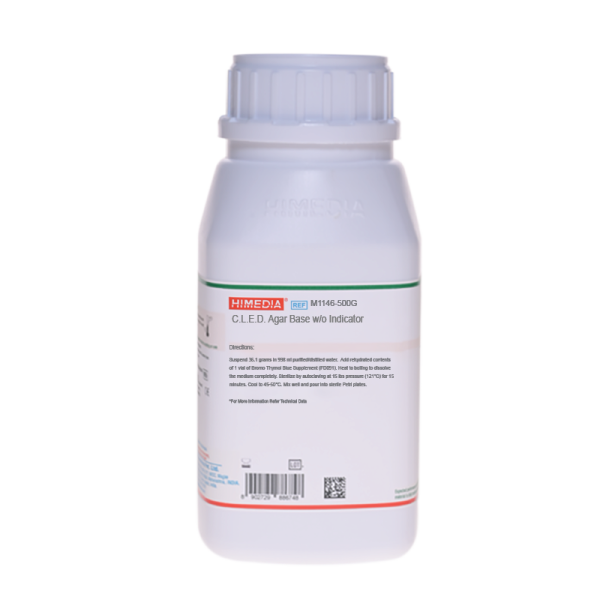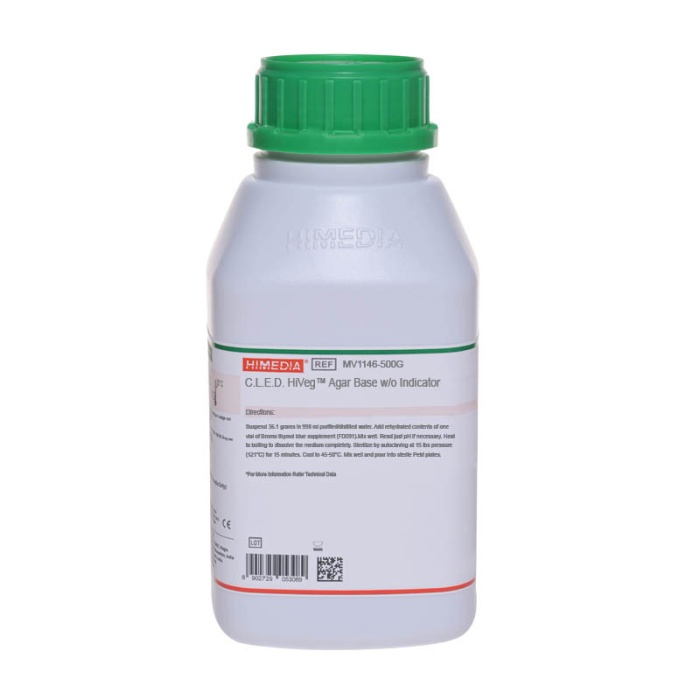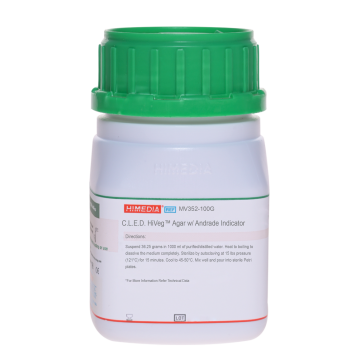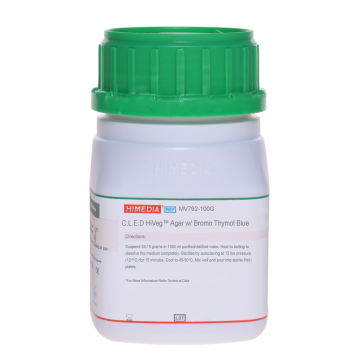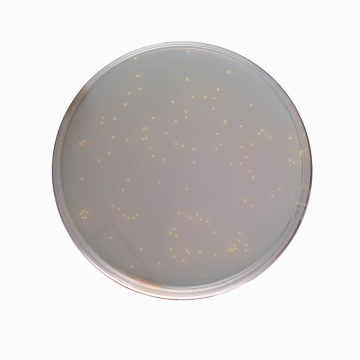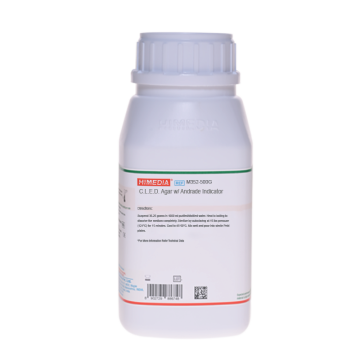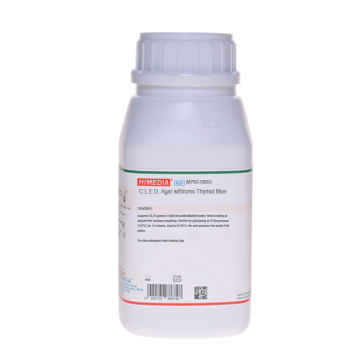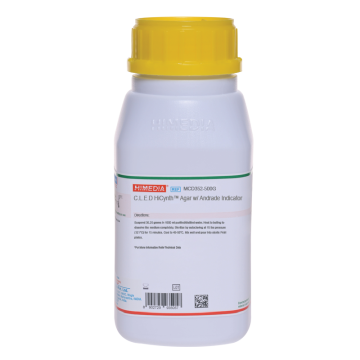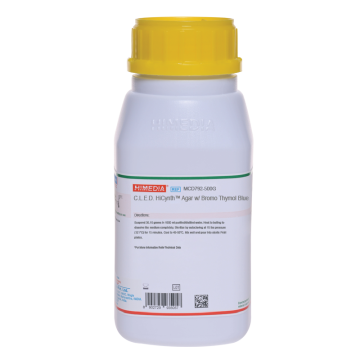 Your enquiry has been submitted
Your enquiry has been submitted
C.L.E.D. Agar Base w/o Indicator
Intended Use
Recommended for isolation, enumeration and presumptive identification of bacterial flora in the urinary tract.
Composition
| Ingredients | g/L |
|---|---|
| Peptone | 4.000 |
| Tryptone | 4.000 |
| HM Peptone B # | 3.000 |
| Lactose | 10.000 |
| L-Cystine | 0.128 |
| Agar | 15.000 |
Final pH (at 25°C): 7.3±0.2
**Formula adjusted, standardized to suit performance parameters #- Equivalent to beef extract
Directions
Suspend 36.1 grams in 998 ml purified/ distilled water. Add rehydrated contents of 1 vial of Bromo Thymol Blue Supplement (FD091). Heat, to boiling, to dissolve the medium completely. Sterilize by autoclaving at 15 lbs pressure (121°C) for 15 minutes. Mix well and pour into sterile Petri plates.
Principle And Interpretation
On a solid medium, Sandy's reported that swarming of Proteus species could be controlled by restricting the electrolytes (1). Formerly swarming of Proteus was controlled by adding alcohol, surface-active agent, sodium azide, boric acid etc. to the medium (1). Later on Sandys medium was modified by Mackey and Sandy's (2), by replacing mannitol by lactose and sucrose and elevating concentration of agar and bromothymol blue. This formulation was further modified by the same authors and called C.L.E.D. (Cystine-Lactose-Electrolyte-Deficient) by deleting the sucrose and by including L-cystine for promoting the growth of cystine dependent dwarf coliform colony (3). This medium is recommended for use in urine bacteriology, promoting the growth of all urinary pathogens. C.L.E.D. Medium is also recommended for dipstick procedures and as dip inoculum transport medium for urine specimens (2,3,4).
Peptone, HM Peptone B and tryptone provides nitrogen and carbon source, long chain amino acids, vitamins and other essential growth nutrients. Lactose is the fermentable sugar. L-cystine supports the growth of dwarf coliform colony. Bromo thymol blue is the pH indicator which turns yellow at acidic pH.
Bacteriuria may be quantitated by inoculating the surface of an agar medium by proper dilution. Inoculate the medium immediately after urine collection. It can also be inoculated by calibrated loop or duplicate dilution pour plate methods (5,6). Shigella species may not grow on this medium. Initiation of antibiotic therapy, before collection sample, low urine pH (less than 5) etc. may result in low bacterial count from infected patients.
Type of specimen
Clinical: Urine
Specimen Collection and Handling
For clinical samples follow appropriate techniques for handling specimens as per established guidelines (7,8). After use, contaminated materials must be sterilized by autoclaving before discarding.
Warning and Precautions
In Vitro diagnostic use only. For professional use only. Read the label before opening the container. Wear protective gloves/ protective clothing/eye protection/face protection. Follow good microbiological lab practices while handling specimens and culture. Standard precautions as per established guidelines should be followed while handling clinical specimens. Safety guidelines may be referred in individual safety data sheets.
Limitations
- This medium is recommended for urine infection. Low urine count may be a result of antibiotic therapy, low pH of urine.
- Recovery depends on the urine count.
- Inoculate the medium immediately after urine collection.
- Shigella species may not grow on this medium.
- For better results, the medium should not be incubated for more than 24 hours because if lactose fermenters predominate the entire medium may turn yellow masking the presence of non-lactose fermenters.
Performance and Evaluation
Performance of the medium is expected when used as per the direction on the label within the expiry period when stored at recommended temperature.
Quality Control
Appearance Cream to yellow homogeneous free flowing powder.
Gelling Firm, comparable with 1.5% Agar gel.
Colour and Clarity of prepared medium With addition of Bromo Thymol Blue Supplement (FD091): Green coloured clear to slightly opalescent gel forms in Petri plates.
Reaction Reaction of 3.61% w/v aqueous solution at 25°C. pH: 7.3±0.2
pH 7.10-7.50
Cultural Response Cultural characteristics observed with added Bromothymol Blue Supplement (FD091), after an incubation at 35-37°C for 18-24 hours.
| Organism | Inoculum (CFU) | Growth | Recovery | Colour of colony |
|---|---|---|---|---|
| Escherichia coli ATCC 25922 (00013*) | 50-100 | good-luxuriant | >=70% | yellow, opaque, center slightly deeper yellow |
| Enterococcus faecalis ATCC 29212 (00087*) | 50-100 | good-luxuriant | >=70% | slight yellowish or greenish |
| Klebsiella pneumoniae ATCC 13883 (00097*) | 50-100 | good-luxuriant | >=70% | yellow to whitish blue |
| Proteus vulgaris ATCC 13315 | 50-100 | good-luxuriant | >=70% | blue |
| Staphylococcus aureus subsp. aureus ATCC 25923 (00034*) | 50-100 | good-luxuriant | >=70% | deep yellow |
| Salmonella Typhi ATCC 6539 | 50-100 | good-luxuriant | >=70% | bluish |
Storage and Shelf Life
Store between 10- 30°C in a tightly closed container and the prepared medium at 2 - 8°C. Use before expiry date on the label. On opening, product should be properly stored dry, after tightly capping the bottle in order to prevent lump formation due to the hygroscopic nature of the product. Improper storage of the product may lead to lump formation. Store in dry ventilated area protected from extremes of temperature and sources of ignition Seal the container tightly after use. Product performance is best if used within stated expiry period.
Disposal
User must ensure safe disposal by autoclaving and/or incineration of used or unusable preparations of this product. Follow established laboratory procedures in disposing of infectious materials and material that comes into contact with clinical sample must be decontaminated and disposed of in accordance with current laboratory techniques (7,8).
Reference
- Sandys, 1960, J. Med. Lab. Technol., 17:224.
- Mackey and Sandys, 1965, Br. Med. J., 2:1286.
- Mackey and Sandys, 1966, Br. Med. J., 1:1173.
- Dixson J. M. S. and Clark M. A., 1968, Conc. Med. Assoc. J., 99 (15)
- Benner E. J., 1970, Appl. Microbiol., 19(3), 409
- MacFaddin J. F., 1985, Media for Isolation-Cultivation-Identification-Maintenance of Medical Bacteria, Vol. I, Williams and Wilkins, Baltimore
- Isenberg, H.D. Clinical Microbiology Procedures Handbook. 2nd Edition.
- Jorgensen, J.H., Pfaller, M.A., Carroll, K.C., Funke, G., Landry, M.L., Richter, S.S and Warnock., D.W. (2015) Manual of Clinical Microbiology, 11th Edition. Vol. 1.
| Product Name | C.L.E.D. Agar Base w/o Indicator |
|---|---|
| SKU | M1146 |
| Product Type | Regular |
| Physical Form | Powder |
| Origin | Animal |
| Packaging type | HDPE |
| References | 1. Dixson J. M. S. and Clark M. A., 1968, Conc. Med. Assoc. J., 99 (15) |
| Customized Product Available | No |



